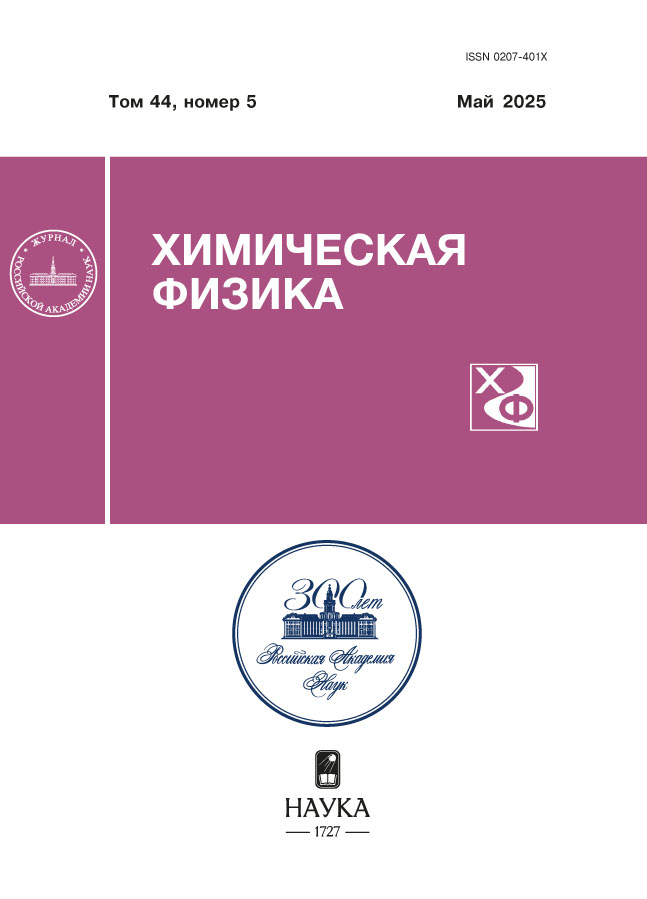The absorption cross sections of cf₃o₂, chf₂o₂ and CF₂O radicals
- Autores: Larin I.K.1, Belyakova T.I.1, Pronchev G.B.1, Trofimova E.M.1
-
Afiliações:
- Semenov Federal Research Center for Chemical Physics, Russian Academy of Sciences
- Edição: Volume 44, Nº 5 (2025)
- Páginas: 40-48
- Seção: Kinetics and mechanism of chemical reactions, catalysis
- URL: https://ter-arkhiv.ru/0207-401X/article/view/683912
- DOI: https://doi.org/10.31857/S0207401X25050051
- ID: 683912
Citar
Texto integral
Resumo
An investigation of photolysis of CHF₂Br, CF₃Br and CF₂ClBr in a mixture with oxygen was carried out at T = 298 K when the mixture was irradiated with a mercury lamp with a maximum radiation at a wavelength of λ = 253.7 nm. Absorption spectra were recorded in the range of 200–900 nm on a Specord M-40 spectrophotometer. The kinetics of photolysis was investigated by the consumption of the initial refrigerant and the accumulation of molecular bromine. The kinetic curves of changes in optical density depending on the irradiation time for CHF₂Br and CF₃Br refrigerants at wavelengths of 214, 224 and 240 nm had inflection points. This effect is explained by the accumulation of RO₂radicals, which in this region of the spectrum absorb UV radiation much more strongly than the original refrigerants. The coordinates of the inflection points made it possible to calculate the absorption cross sections of CF₃O₂ and CHF₂O₂ radicals at wavelengths of 214, 224 and 240 nm. For CF₂ClBr freon, the optical density at a wavelength of 222 nm decreased linearly during the entire irradiation time in accordance with the linear accumulation of photolysis products – BrCl and CF₂O. This allowed us to estimate the upper limit of the absorption cross-section of the CF₂O photolysis product.
Palavras-chave
Texto integral
Sobre autores
I. Larin
Semenov Federal Research Center for Chemical Physics, Russian Academy of Sciences
Email: eltrofimova@yandex.ru
Rússia, Moscow
T. Belyakova
Semenov Federal Research Center for Chemical Physics, Russian Academy of Sciences
Email: eltrofimova@yandex.ru
Rússia, Moscow
G. Pronchev
Semenov Federal Research Center for Chemical Physics, Russian Academy of Sciences
Email: eltrofimova@yandex.ru
Rússia, Moscow
E. Trofimova
Semenov Federal Research Center for Chemical Physics, Russian Academy of Sciences
Autor responsável pela correspondência
Email: eltrofimova@yandex.ru
Rússia, Moscow
Bibliografia
- Larin I.K., Belyakova T.I., Messineva N.A. et al. // Russ. J. Phys. Chem. B 2021. V. 15. № 5. P. 795. https://doi.org/10.1134/S1990793121050195
- Noto T., Babushok V., Hamins A. et al. // Combust. and Flame. 1998. V. 112. № 1–2. P. 147. https://doi.org/10.1016/S0010-2180(97)81763-4
- Papanastasiou D.K., Carlon N.R., NEᵤman J.A. et al. // Geophys. Res. Lett. 2013. V. 40. № 2. P. 464. https://doi.org/10.1002/grl.50121
- Montreal Protocol on Substances that Deplete the Ozone Layer. United Nations Environment Programme (UNEP). Montreal: Halons Technical Options Committee (HTOC), 2006.
- Natl. Inst. Stand. Special Publication 1069. Washington: U.S. Government Printing Office, 2007.
- Larin I.K. // Russ. J. Phys. Chem. B 2022. V. 16. № 3. P. 492. https://doi.org/10.1134/S1990793122030083
- Linteris G.T., Fumiaki T., Katta V.R. // Combust. Flame. 2007. V. 149. № 1–2. P. 91. https://doi.org/10.1016/j.combustflame.2006.12.013
- Halocarbons: Ozone Depletion and Global Warming Overview. Washington: NASA. 2006.
- Lightfoot P.D., Cox R.A., Crowley J.N. et al. // Atmos. Environ. Part A. 1992. V. 26. № 10. P. 1805. https://doi.org/10.1016/0960-1686(92)90423-I
- Biggs P., Canosa-Mas C.E., Fracheboud J.-M. et al. // Geophys. Res. Lett. 1995. V. 22. № 10. P. 1221. https://doi.org/10.1029/95GL01011
- Nielsen O.J., Sehested J. // Chem. Phys. Lett. 1993. V. 213. P. 433. https://doi.org/10.1016/0009-2614(93)89139-9
- Wallington T.J., Hurley M.D., Schneider W.F. // Chem. Phys. Lett. 1993. V. 213. P. 442. https://doi.org/10.1016/0009-2614(93)89140-D
- Tyndall G.S., Cox R.A., Granier C. et al. // J. Geophys. Res. 2001. V. 106. № D11. P. 12157. https://doi.org/10.1029/2000JD900746
- Wallington T.J., Dagaut P., Kurylo M.J. // Chem. Rev. 1992. V. 92. № 4. P. 667. https://doi.org/10.1021/cr00012a008
- Nielsen O.J., Ellermann T., Sehested J. et al // Int. J. Chem. Kinet. 1992. V. 24. № 11. P. 1009. https://doi.org/10.1002/kin.550241111
- Nielsen O.J., Ellermann T., Bartkiewicz E. et al. // Chem. Phys. Lett. 1992. V. 192. № 1. P. 82. https://doi.org/10.1016/0009-2614(92)85432-A
- Maricq M.M., Szente J.J. // J. Phys. Chem. 1992. V. 96. № 12. P. 4925. https://doi.org/10.1021/j100191a037
- Wallington T.J., Ball J.C., Nielsen O.J. et al. // J. Phys. Chem. 1992. V. 96(3). P. 1241. https://doi.org 10.1021/j100182a041
- Barker J.R. Progress and Problems in Atmospheric Chemistry. Singapore: World Scientific Publishing Company, 1995. https://doi.org/10.1142/2455
- Sehested J.. Atmospheric Chemistry of Hydrofluorocarbons and Hydrochlorocarbons. Roskilde, Denmark: Riso National Laboratory, 1995.
- Semenov N.N. Chain reactions. Moscow: Nauka, 1986.
- Belyakova T.I., Larin I.K., Messineva N.A. et al. // Russ. J. Phys. Chem. B 2018. V. 12. № 2. P. 352. https://doi.org/10.1134/S1990793118020045
- Chemical Kinetics and Photochemical Data for Use in Atmospheric Studies. Evaluation No. 17. JPL Publication 10-6. Pasadena, Jet Propulsion Laboratory, 2011. http://jpldataeval.jpl.nasa.gov
- Larin I.K., Belyakova T.I., Messineva N.A. et al. // Kinetics and Catalysis. 2014. V. 55. № 5. P. 549. https://doi.org/10.1134/S0023158414050085
- Belyakova T.I., Larin I.K., Messineva N.A. et al. // Kinetics and Catalysis. 2017. V. 58. № 2. P. 105. https://doi.org/10.7868/S0453881117020010
- Ugarov A.A. Candidate’s thesis for the degree of Candidate of physical and mathematical Sciences. Moscow: INEPCP RAS, 2003.
Arquivos suplementares
















